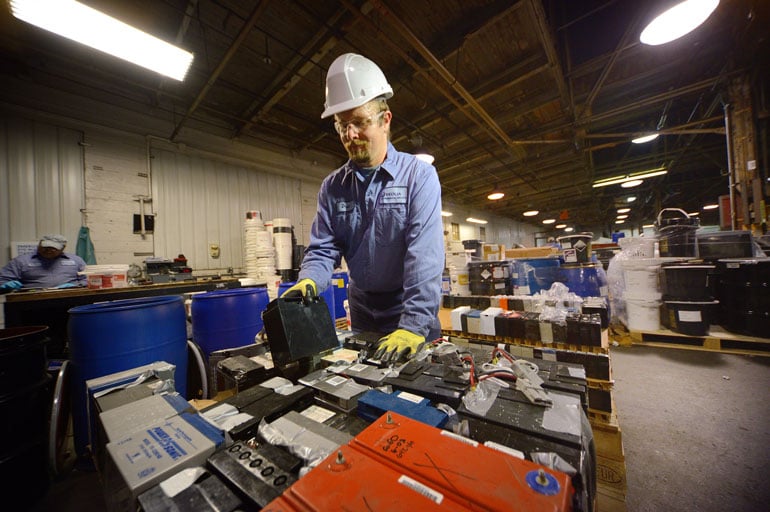Batteries are more prevalent today than they have ever been in our history. They power everything from our handheld devices to our vehicles, and many things in between. As dry cell, alkaline, lead acid, and lithium ion batteries are used for more and more applications, their proper storage and transport is crucial to preventing accidents and ensuring safety.
In this article, we’ll cover the battery basics so you know exactly how to handle, package, store, move, and dispose of them properly.
The danger batteries pose
Everyone involved in handling batteries of any kind should be aware of the hazards that they can create. Whether they are in use, charging, or just in storage, they can be dangerous to people and structures around them if the right steps aren’t taken. Potential problems include:
- Overheating
- Fire or explosion
- Electrical shock from battery chargers
- Thermal burns
These battery related hazards can lead to injuries, fatalities, and the loss of property. For example, improperly handled lithium ion batteries are responsible for a large number of workplace related injuries every year. According to the EPA, 64 waste facilities in the U.S. experienced a total of 245 fires that were caused or likely caused by lithium ion batteries. Most if not all of these incidents could have been avoided with proper handling, storage, and transport.
But lithium ion batteries aren’t the only threat. Traditional lead acid batteries, and ones as small as dry cell 9 volt batteries that you buy in the grocery store, can all pose a serious risk to the health and safety of people around them.
The question is, how can you prevent accidents like these from happening? Let's look at some basic guidelines.
Battery package and storage safety guidelines
- Only chemically compatible batteries may be packaged together
- Use inner packaging of non-conducive material to prevent short circuit or damage to terminals
- Packaging must be adequate to withstand travel conditions, like bumps, turns, and acceleration
- Store batteries in a cool, dry location
- Leaking batteries must be packaged separately and may be subject to regulation as a hazardous waste
- Batteries secured to a pallet are considered a non-bulk package and must be labeled and marked accordingly
Prevent short circuiting and protect the terminals
Short circuiting is a huge danger of transporting many different types of batteries. When it comes to protecting exposed terminals, it’s crucial to package each battery or battery powered device in a fully enclosed inner packaging made of non-conducive material.
You’ll also want to cover the terminals using non-conducive caps or tape. Tape, caps, and other insulation must be clear to ensure they do not obscure the battery identification markings. Plus, you should always cushion the batteries to prevent shifting or movement that might damage or loosen the terminals.
How to safety transport each type of battery
Let’s look at important transportation and storage basics for the most common types of batteries.
Lead acid batteries
Lead acid batteries are the most common type of rechargeable battery. To ensure safe storage and prevent accidents, they should only be packaged in UN 1G, 4G, or 1H2 non-metal containers. Plus, you need to use non-conducive plastic strapping and stretch wrap to prevent battery movement within the container and to secure their containers to the pallet. You never want to use metal restraints, because it could result in serious injury.
Lithium ion batteries
Lithium ion batteries are becoming increasing popular to power everything from handheld electronics to electric vehicles. But they also present the greatest danger of fire or explosion. For that reason, they must be packaged to prevent the dangerous evolution of heat, and short circuit protection has to cover all battery terminals. To assure accident free transport, lithium ion batteries should be stored individually in clear plastic bags or packages with clear tape over the terminals.
Wet lithium ion batteries
Wet lithium ion batteries are lithium ion batteries that have been exposed to or submerged in water or oil. Batteries that have been submerged are considered damaged and dangerous, because they are likely to create sparks or generate heat. For that reason, you are not allowed to transport wet lithium ion batteries.
Nickel cadmium wet call batteries
Similar to lead acid batteries, these types of batteries should only be packaged in UN 1G, 4G, or 1H2 non-metal containers. The containers that you use must be rated for the weight loaded into them and include non-conducive packaging to keep the batteries from shifting around during transport.
Battery recycling and disposal

Used batteries may be classified as hazardous waste under the Federal Resource Conservation and Recovery Act (RCRA), because they might contain corrosive liquids, toxic heavy metals, or reactive metals. Because of this classification, battery waste must be properly identified, stored, transported, and stored according to federal regulations. Waste generators are financially responsible for cleaning up the effects of improper disposal.
Whether lead acid, lithium ion, alkaline, or other type, you should never discard batteries in the trash or municipal recycling bins.
Always find out the guidelines and regulations
We covered a few specific batteries in this article, but different types may have varying requirements, regulations, and storage and handling best practices. If you are transporting or storing a specific type of battery, make sure you understand all the applicable guidelines. Don’t assume that because you’ve moved one type of battery that the requirements are the same for a different type. Always put in the extra effort to prevent fires, injuries, or other accidents.


